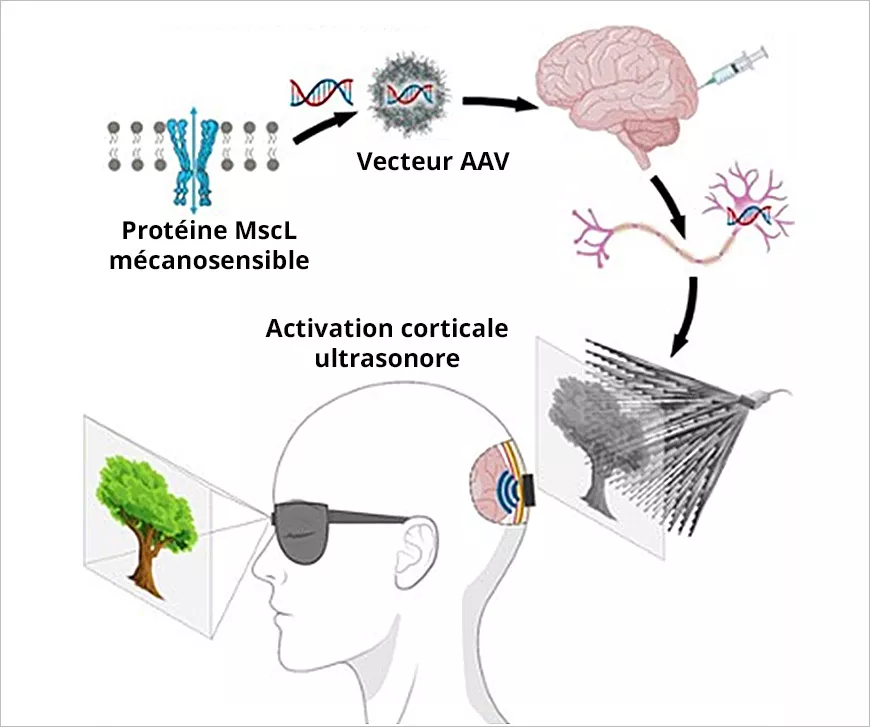Chronic glaucoma
Glaucoma benefits from systemic or frequent screening during a visit to the ophthalmologist because it is a painless and insidious disease. It goes unnoticed until vision is irreversibly damaged. Early detection is therefore essential, as is good compliance with treatment.
Disease simulation

Definition and symptoms
What is chronic glaucoma?
Chronic glaucoma is a pathology of the optic nerve often accompanied by intraocular hypertension. This causes nerve fibers to compress and destroy, preventing visual information from being transmitted to the brain.
If left untreated, this disease can lead to blindness.
Who can be affected?
Chronic glaucoma affects men and women from the age of 40, 1 million people are concerned in France.
The risk is significant for people with a family history of glaucoma. The causes are diverse.
How does it affect patient?
At first, no signs are felt. It’s important to consult an ophthalmologist for prevention, especially if there is a family history.
Then a progressive alteration of the visual field is felt as well as a decrease in visual acuity (blurred vision) despite an adapted optical correction.
Treatments for chronic glaucoma
Drug treatments (eye drops) exist to stabilize chronic glaucoma, hence the importance of early management.
Sometimes, surgery may be necessary to stabilise the disease.
Possible difficulties faced by people with chronic glaucoma
It becomes difficult for people with chronic glaucoma to avoid obstacles on the street: poles on sidewalks, holes in the pavement, a passerby, a stroller, etc. Spot and recognise signs in the distance: street signs, pedestrian lights, etc. also becomes difficult.
If the disease is at an advanced stage, then it becomes complicated to read information on a screen, a book, a newspaper, etc. and find and recognise specific information: off-the-shelf folder, off-the-shelf product, etc
Link to the web Tv: EPISODE #1 THE GLAUCOMA :
Research by the Institut de la Vision
Sonogenetics, a brain/sonogenetic machine interface to restore sight
Glaucoma can lead to blindness because optic nerve atrophy is usually irreversible. The pathology therefore cuts off the communication between the eye and the brain. Research teams at the Institut de la Vision are studying how to reintroduce visual information directly into the brain for people who have gone blind. In this case, we are talking about sensory substitution. Failing eyes need to be replaced by a machine that stimulates the visual cortex.
In 2023 at the Institut de la Vision, Professor Serge Picaud, Mikael Tanter and their team are proving that it is possible, thanks to ultrasound, to activate genetically modified neurons to restore vision. This therapy is called sonogenetics. It consists of making neurons in the brain sensitive to ultrasound. The technique makes it possible to apply ultrasound images to the visual cortex, following the transformation of images acquired by camera glasses worn by the blind person. To perceive ultrasound images, the patient's neurons will need to be genetically transformed by gene therapy to express an ultrasound-sensitive protein.
Principe de la thérapie sonogénétique

This method offers high spatiotemporal resolution and does not require any physical contact with the brain.
The study showed that the therapy works on different types of neurons, whether they are in the retina or in the visual cortex of rodents, demonstrating the universality of this approach.
By converting images of our environment into an ultrasound wave encoded to directly stimulate the visual cortex, at rates of several dozen images per second, sonogenetic therapy appears to be a real hope for restoring sight to patients who have lost optic nerve function.
